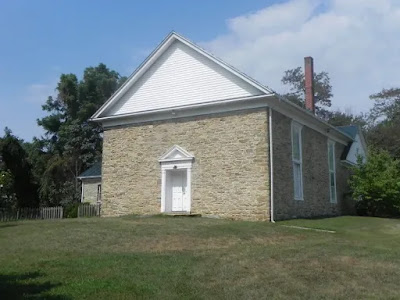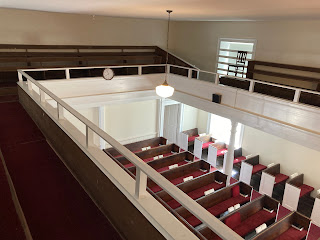 |
Benjamin Richard Lunceford
Company C, 8th Virginia Infantry
|
When my aunt, Dorothy Lunceford Ayres passed at 99 in 2014, we discovered among her things the entire muster records of her grandfather (my great-grandfather) Benjamin Richard Lunceford (1837-1900). Benjamin Richard was married to Amanda Creel and they had 8 children, my grandfather, Benjamin Harrison (1881-1931) was one of them. Sparked by this find, I started to investigate Benjamin Richard and have come to discover quite a bit about him, his brothers and cousins and their service in the American Civil War.
As a child we visited the Warrenton Cemetery at holidays and saw the cast Confederate Veteran iron cross at the base of Benjamin Richard’s headstone (located directly behind my grandparents) but was unaware of his Civil War service. Growing up I never really heard many ancestral service stories other than my uncle Carlton Lunceford (KIA Anzio WWII). I think it was because my grandfather died in 1931 in a farm accident and my grandmother Addie Pearl Griffith Lunceford died in 1960 when I was 4. So the stories had faded.
On another note, my father John Turner was from Newport, Kentucky (across from Cincinnati). His grandfather, Thomas Z. Turner, was in the Union Army with the 155th Pennsylvania Volunteer Infantry. He appeared to have enlisted in 1862 and served until June of 1863 just prior to the Gettysburg campaign.
When reviewing old historical documents, I need to qualify some of my findings. Getting fully sourced information is difficult and sometimes you must read between the lines or make assumptions based on deduction. There are also some contradictions and assertions in conflict from one account to another. If you are reading this, you may have family lore that I am not aware of and could add to the discovery. Any information you would like to share can be added to the comments at the end of this post.
Ancestor Lineage and Civil War Muster Records
I have tried to include all Lunceford/Lunsford brothers and cousins as I could confirm. But there are cousins that I have yet to investigate. They would be Creels and Balls, etc., and they are offspring of the daughters of Baldwin and or Benjamin. Number to the right of birth/death in [..] is age in 1861. Click on the name to go to their family sheets in the database.
Baldwin Lunceford/Anna Ball > Benjamin >
1) Benjamin Richard - (1837-1900 [24]) - 8th VA INF
2) Evan Owen - (1833-1901 [28]) - 8th VA INF
3) Elijah Chilton - (1829-1921 [32]) – 43rd VA CAV (Mosby’s Men)
Baldwin Lunceford/Anna Ball > Benjamin > James W. >
4) John Henry - (1846-1934 [15]) – 43rd VA CAV (Mosby’s Men)
5) James William Jr. - (1848-1935 [13]) – 43rd VA CAV (Mosby’s Men)
Baldwin Lunceford/Judith Creel > Wormley >
6) Joseph Blackwell - (1841-1861 [20]) - 8th VA INF
7) William A. - (1843-1864 [18]) - 6th VA CAV
Baldwin Lunceford/Judith Creel > Harrison >
8) James D. - (1834-1864 [27]) - 8th VA INF
9) Samuel - (1844-???? [17]) - 16th VA INF
1) Benjamin Richard Lunceford (my great grandfather, sometimes called “Benedict” Lunsford and “Lansford”), Company C, 8th Virginia Infantry. He mustered into service on July 13th, 1861 in Leesburg by Capt. Edmund Berkeley. He seemed to be somewhat of a rascal as I have found references to him as being a sharpshooter and possibly credited with shooting Col. Edward Baker (a sitting United States Senator from Oregon) at The Battle of Ball’s Bluff in October 1861 (Note 1). He also is known for his shooting skills at The Angle during the battle of Gettysburg, July 1863 where he and two other Luncefords (his brother Evan and cousin James) fought. He and his cousin James were captured, as reflected in their muster records. He is listed as a private, corporal, sergeant and even a Colonel in different excerpts and as having been admitted to the famous Chimborazo Hospital in Richmond for something called ‘Catarrh Fever’ from June 12 - 23 1862. He was imprisoned at Ft. Delaware Prison and later paroled at Point Lookout, MD February 18th, 1865. Buried in the Warrenton cemetery.
2) Evan Owen Lunceford (my great grandfather’s brother) Company C, 8th Virginia Infantry, listed as wounded at Gaines Mill (also Chickahominy) June 27, 1862. Listed as captured July 3rd, 1863 (in some excerpts) at the Angle, Gettysburg along with Benjamin and their cousin James D. However, his muster records are contradictory as to capture where Benjamin's and James D. records clearly state that they were captured July 3, whereas Evan’s record does not. Buried in the Oak Grove Baptist cemetery, Greenwich, VA.
3) Elijah Chilton Lunceford (my great grandfather’s brother). He rode with Mosby’s Raiders, Company E. His service is described in a previous post (Note 2). Buried at the Marshall Cemetery.
4) John Henry Lunceford (my great grandfather’s nephew) - Signed on with Mosby at the very young age of 16 or 17 as a scout(?). Listed as captured by the Federals with some controversy that can be researched elsewhere. Buried in the Westminster cemetery, Delaplane, VA (Note 3).
5) James William Lunsford (my great grandfather’s nephew) - Also rode with Mosby (Company E) as a scout(?) albeit briefly in 1864-5 as he too was barely 15 or 16 years old.
6) Joseph Blackwell Lunceford (my great grandfather's 1st cousin) 8th Virginia Infantry. Killed approaching the old Stone House at First Manassas, July 21, 1861. Wound listed as through the heart. Believed buried in a mass grave at the Groveton Cemetery on the battlefield (Note 4).
7) William A. Lunceford (my great grandfather's 1st cousin) 6th Virginia Cavalry. Died in hospital, Winchester, VA, 12 Nov 1864 from wounds sustained two months earlier at Newtown (Stevens City). His burial is at the Stonewall Confederate cemetery in Winchester, VA (section VA-95) (Note 4).
8) James D. Lunceford (1st cousin to Benjamin and Evan). Company F, 8th Virginia Infantry. Reported as wounded at Gettysburg and listed as “having killed more Federals than any in other” that day. His muster records are interesting and contain some controversial statements. For instance, he is listed as present March & April 1863, absent September & October 1863 and November & December 1863 - “Taken prisoner at Gettysburg July 3, confined in Ft Delaware”. For the period January & February 1864, the remarks say “Made prisoner at Gettysburg July 3, 1863. Afterwards joined the enemy. Deserter”. Reported as died in captivity at the notorious Ft. Delaware Federal Prison, March 12, 1864 due to inflamed lungs. He was also wounded at Darbytown June 30, 1862 and sick in 1861 (Note 5).
9) Samuel Lunceford, 16th Virginia infantry. Many listings for being sick (Impetigo, lower left thigh infection, scurvy or wounded) also at Chimbarzo and the Episcopal Church Hospital, Williamsburg.
Notes:
1) Regarding the battle of Ball's Bluff, from: “The 8th Virginia Infantry Regiment, "The Bloody Eighth" by JDWoody.
“Hunton ordered his skirmishers out into the adjacent tree line to open fire on the commander and his men. Sergeant Benedict R. Lunceford led his squad into the trees to open fire on the Yankees. Loading his Model 1861 musket, Sergeant Lunceford took aim at Colonel Baker. Readying his shot, he squeezed the trigger and fired, sending a roundball through the neck of Colonel Baker. The Union colonel fell to the ground grasping his bloodied neck, choking to death on his blood. Sergeant Lunceford had just killed the first and only U.S. Senator to die in combat.”
In Benjamin Richard’s service record, there is no listing as being a sergeant, nor is there any other evidence for his role in the Baker shooting. This point requires more research.
From: “Pickett’s Charge: A New Look at Gettysburg’s Final Attack”. By Phillip Thomas Tucker, PhD. Skyhorse Publishing, NY 2016.
“Tragedies among Brothers…..Meanwhile, two sets of 8th Virginia brothers, advanced side by side: Privates John L. Bailey and Edwin S. Bailey of Company D (Champe Rifles),………and Corporal Benjamin R. Lunceford and Private Evan[s] O. Lunceford, both of whom enlisted in the summer of 1861 at Leesburg, Virginia of Company C (Evergreen Guards)………”
“Savage Hand-to-Hand Combat at the Copse of Trees…… The men who had gained the stone wall and the clump of trees continued to inflict damage on the resurgent Yankees, especially the 69th Pennsylvania. One Rebel excelled in the grisly art of killing his fellow man. He was an expert marksman who never missed a shot. Firing through a narrow gap in the stone wall where piled-up stones had either knocked down or deliberately removed, Private James D. Lunceford, of Company F (Blue Mountain Boys), 8th Virginia, on the far right of Garnett’s brigade, blasted away through this ideal firing position that provided protection. Meanwhile, comrades, including a brother, hurriedly hand-loaded and passed muskets to Lunceford in an assembly line of death. Because of the density of the encroaching blue ranks, some of Lunceford’s well-aimed bullets dropped two men with a single shot, with the bullet whizzing completely through the foremost Federal to find another victim immediately behind him. From this vantage point, this especially young Blue Mountain Boy “killed more men than any other during the assault.” However, Lunceford fell wounded and was captured. He was fated to die a captivity prisoner in a filthy northern prison, earning a shallow grave in New Jersey soil in 1864. James paid the ultimate price for “getting two [Yankees] at a crack”.”
From: “Pickett’s Charge – The Last Attack at Gettysburg” by Earl J. Hess. The University of North Carolina Press, 2001.
“The same process took place among many other groups along the outside of the stone fence. First there was fierce defiance, then there was doubt about the prospects of help arriving, then there was the grim realization that a decision between flight and capture had to be made. Lt. Charles Berkeley of the 8th Virginia gave his handkerchief to Cpl. Benjamin R. Lunceford and told him to put it on a ramrod and wave it as a token of surrender. But Lunceford was so intent on firing, having been supplied with a steady source of off-loaded and capped muskets by his brother, that he exclaimed, "Hold on awhile Lieut. I am getting two at a crack." His comrades later argued that no one in the division killed more Yankees during these few minutes than Lunceford.”
2) See previous post, “Family Mementoes and Warrior Ancestors”.
3) See previous post, “A Close Encounter with COL Mosby's Pistol”.
4) See previous post, “A Priceless Family Heirloom; Wormley and Mahala's Bible”.
5) See previous post, “Guest Post: Which John?”
Carl Turner

































